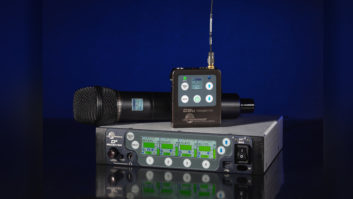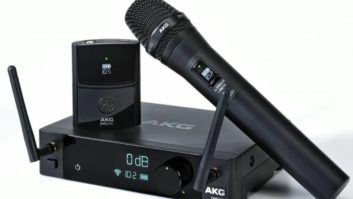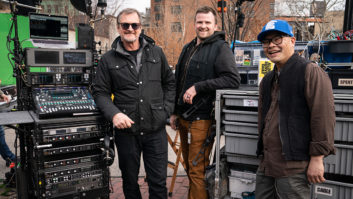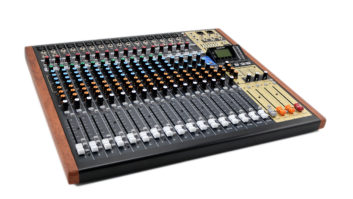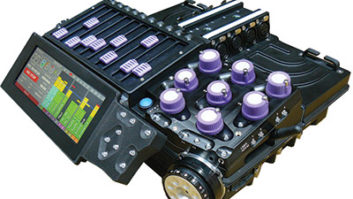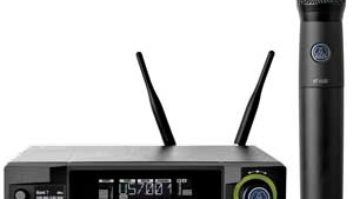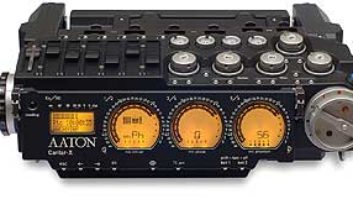Bear with me on this one. A couple years ago, I was working on location in New York City. While shooting exteriors with Ian Holm and Stanley Tucci, my mixer fried. A little puff of smoke, that nasty smell of burning carcinogens, and I was dead in the water. The board was a Soundcraft, heavily modified with pre-fade outs, to feed my Nagra D. My chances of finding another on short notice and doing the mods was nil. Fortunately, the problem was the DC-DC Converter board, and Soundcraft USA happened to have one in stock. I received the circuit board the next morning and got to the set early enough to do some surgery and get back into action. What does this have to do with digital wireless? Hang in there…
The incident with the mixer made me realize that the board was the weak link in my sound package. It was time to get a new board. Hopefully, one that I wouldn’t have to modify and one that would be readily available in the event I needed to rent one in a pinch.
That same day, I saw an ad from a company I’d never heard of (Zaxcom) for a mixer I’d never heard of (the Cameo). The board looked great in the ad, but then again, don’t all new products? Skeptical but curious, I drove out to New Jersey to meet with Zaxcom’s owner, Glenn Sanders. The Cameo was not ready for sale, but Glenn showed me a prototype and described what it would do. It sounded too good to be true, so I remained skeptical. At the same time, he told me that he was working on digital wireless mics. Yeah, right.
Six months later, Zaxcom released the Cameo and, being the fool that I am, I purchased serial number 0001. It did everything advertised and then some. A few months after that, I purchased Zaxcom’s other gizmo, the Deva, a 4-track, hard drive field recorder. Impressed with the imagination and engineering of these machines, I started asking about the digital radios. “They’re in the works,” I was told. Occasionally, I would stop by Zaxcom for a software upgrade and Glenn Sanders would show me a spindly mass of tiny circuit boards attached to a scope by alligator clips. “It worked across the room!” he said. (“Watson, come here. I need you,” I thought.)
Around that time, I saw an article in one of the sound journals that explained why digital radios would not be appearing any time soon — if ever. Apparently, there was not sufficient spectrum to allow for the legal transmission of high-resolution digital audio. Even if there were sufficient spectrum, the transmitter would be huge, would need a car battery for power and would have insufficient range for professional use. The article was convincing. I faxed it to Zaxcom and heard no more about digital radios. For a few weeks at least…
THE TEST: ON LOCATION
Anyway, in mid-November 2001, Sanders came to visit me on location in Brooklyn. I was mixing a film called Brown Sugar, a hip hop romance starring Taye Diggs, Sanaa Lathan and Queen Latifah. Sanders had brought along his “digital wireless.” We were about to do a walk and talk with two characters. Glenn had wired up a Sanken COS11 for his unit, so I gave my assistant, Schavaria Reeves, the Zaxcom and one of my Audio Ltd. TX2020s (also with a Sanken), and sent him off to wire the two actresses while I hooked up the receiver. You might think I was a bit bold to take an unknown piece of equipment and put it right to work on a character in a film. But at that point, I had been using Zaxcom equipment as the heart of my sound cart for nearly two years. I knew the equipment would do what Sanders said it would. (I also knew that Schavaria was a whiz with radios and could quickly rewire the actress with an Audio Ltd. if I ran into trouble.)
We did two rehearsals. The walk-and-talk scene covered about half a city block. My cart was positioned at the end of the run, for a total range of about 125 feet. The first thing I noticed was that the Zaxcom sounded very good. Too good. I asked Schavaria to replace the Sanken on the character with the Audio Ltd. I was assuming the problem was either a bad mic or bad mic placement. It was neither. The digital wireless sounded so good that my boom person was able to tell which character had the Zaxcom by listening over his wireless Comtek feed. I own eight Audio Ltd. RF mics. The 2020s are probably the best analog wireless mics made (they should be, they cost over $4,000 a pop), but the audio quality of the Zaxcom blew them out of the water.
Our next scene was on the Brooklyn Heights Promenade, a beautiful park overlooking Manhattan’s sadly diminished skyline. I’ve shot there many times and know that it is not a radio-friendly environment. It is over a major highway (the infamous BQE — Brooklyn/Queens Expressway) and is in direct line of sight of every major transmission tower in Manhattan. The scene we were going to shoot was also a two-person walk-and-talk, though it was a longer scene and would cover more territory (a little more than 200 feet). Again, I was set up at the end of the dolly run.
Before we got too established, I sent Schavaria out on a test. I wired him with an Audio Ltd. and the Zaxcom transmitter and sent him on a walk. He easily passed the length of the shot and went about another 150 feet. At that point, the digital radio was out of range and started to mute. Literally a few steps later, the analog radio also went dead.
Although it seemed that the analog radio had the greater range (if only slightly), things changed when we actually shot. Now we had two characters wired with the transmitters on the small of their backs, facing away from the receivers. We also added a camera and dolly, 20 or so people, a doorway dolly with a huge light rig (which, somehow, the grip and lighting crew rigged for silent running…thanks, guys), and many lights and spectators. The range of both radios dropped almost by half. With the actors at “one,” the Audio Ltd. was now “fritzing.” The Zaxcom receiver was showing intense digital-error correction, but the signal was clean — none of the error correction was audible. Fortunately, the character with the Zaxcom had the first few lines. By the time the woman with the analog radio spoke, she was back within range. While there are always sound differences between two characters wearing lavalier mics due to clothing, the placement on the body, the tone of their voices, etc., the digital radio immediately sounded better. After we shot the scene, I asked for room tone and recorded it off of the two lavs. Then it became apparent why the digital sounded so much better: Listening back and forth between the two mics while recording the quiet street ambience (it was now after midnight), I realized that there were no artifacts on the Zaxcom. The backgrounds on the analog lav were “pumping,” whereas the sound from the digital was absolutely clean.
I’ve been spoiled by my Cameo mixer. It has superb preamps and A/D converters. The Zaxcom digital radio has the same preamp and converter and, unlike the way it is with the mixer, you cannot overload the transmitter’s front end because it has analog limiting before the A/D. Like the mixer, the wireless is a 24-bit, high-resolution digital device, and you can set the transmitter gain very low, because there is no noise. You can set it low, let people whisper, and then when they yell, there is no compression. One note about this test — I was taking an analog output from the receivers. As good as they sounded, I imagine they will sound even better when I take an AES out because I’ll be eliminating one of the D/A conversion steps.
The test radio I used was from the production hardware run, but the software wasn’t complete. Some software features weren’t ready at the test, and other diagnostic features were only included for the test. Like all digital recorders, the digital radios include error-correction algorithms. I could watch the amount of error correction occurring on the receiver display. (I’m hoping that Zaxcom keeps the error-correction diagnostic display feature on the production units.) The receiver was correcting what would have been static and noise on the analog unit. According to Sanders, the software in the radios will be upgradeable, and Zaxcom expects to be able to improve the range significantly as the software develops. Because the range of the test unit was essentially equal to my analog radio, any improvement will be gravy. One feature that will be on the production units but was not on the test unit is channel scanning. The receiver will scan all the frequencies in its range (which I believe is 30 MHz, much greater than the 7 Mhz on the Audio Ltd.’s) and assign the best channel.
SUMMING IT UP
The beauty of digital means that many product improvements will be software-driven. The Cameo mixer I have now is already very different from the one I purchased two years ago, and the improvements have been major, but they only involved the replacement of a ROM chip. Zaxcom incorporates user ideas into new software releases, and changes that would require major and expensive hardware modifications on an analog board can be achieved with a simple chip replacement. I believe the same will hold true for these radios. Five years from now, the radio you have will probably be better than the one you purchased. I can’t say this about my analog radios. They degrade over time. Components go out of tune, and their effective range has dropped because the frequencies they are locked into have become more crowded. Which leads to another point: The digital radios use very few tunable components. They will require much less service than the analog radios. I’ve already ordered two Zaxcoms. Hopefully, I’ll get numbers one and two to go with my Cameo. I have no qualms about being first; there will be improvements. (I’ll probably drive some of them after using the units for a few weeks!) Zaxcom will write new software, and, after an hour in the shop, I’ll essentially have a new unit. I guess that is the point of this. Analog radios are as good as they are going to get. This digital radio is already better than the best analog, and it is going to keep getting better over time.
William Sarokin is a first-call production sound mixer with credits including Simply Irresistable, Return to Paradise and Big Night.
ZAXCOM TEST RESULTS
The Pros and Cons
PROS
Very clean audio. Not only does it sound like a hardwired microphone, but it sounds like a hardwired microphone through a very good preamp.
Transmitter size. The transmitter is much smaller than other existing transmitters (2.1×.53×3.25 inches). An even smaller transmitter is in the works. I believe Zaxcom will also release smaller batteries (because the battery makes up half the size of the transmitter) for shots where space is at a premium.
Range. Comparable to analog, range is likely to improve as the software improves.
Frequency-agile. The units cover a range of 30 MHz. The receivers will scan to select the best open frequency.
Privacy. The digital signal cannot be monitored on a scanner.
Digital-error correction. This is my favorite. What would be audible static and noise on analog radios are digitally corrected and rendered inaudible.
Others. Analog and digital outputs, transmitter remote control.
CONS
Receiver size. The receivers are bigger than I’d like (4.2×1.3×5.8 inches).
Receiver powering. The receivers do not take internal batteries. They need external 12 V @ 350 ma.
Quad box. Zaxcom is designing a “six-pack.” This is a pro and a con. It won’t be as elegant as the Audio Ltd. Quad box, but then again, it will hold six units, something I’ve been bugging Audio Ltd. about for years.
Rechargeable transmitter batteries. (Also a pro.) The transmitters use rechargeable Lithium Ion batteries. The battery life seemed equivalent to the 9 volts in the Audio Ltd. But it will take some getting used to, keeping the recharging station going. I see this as more of a pro once I’m used to it.
Delay. With all the processing going on, there is a 3ms delay (equivalent to three feet, or <1/10th of a frame). When mixing analog and digital mics together in a scene, it takes a little getting used to, because the two mics will phase at different points than usual. With the Cameo, I can compensate by dialing in 3ms delay on the analog radios. Without the Cameo, it’s just a matter of getting used to it.
— William Sarokin
